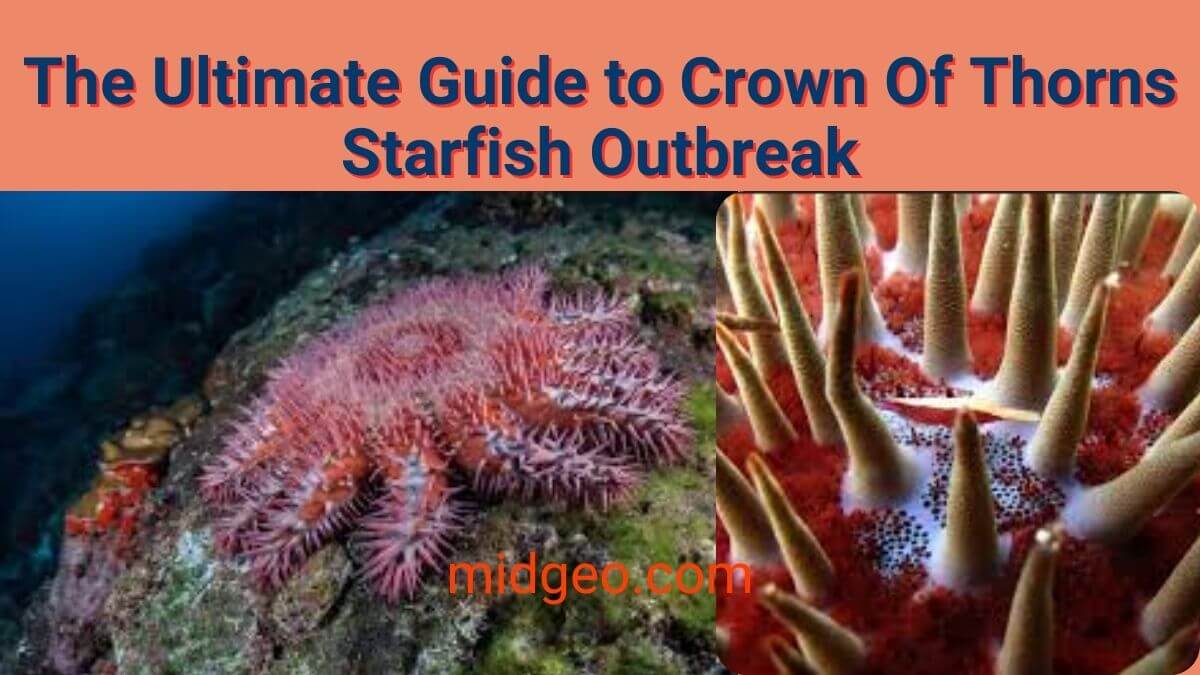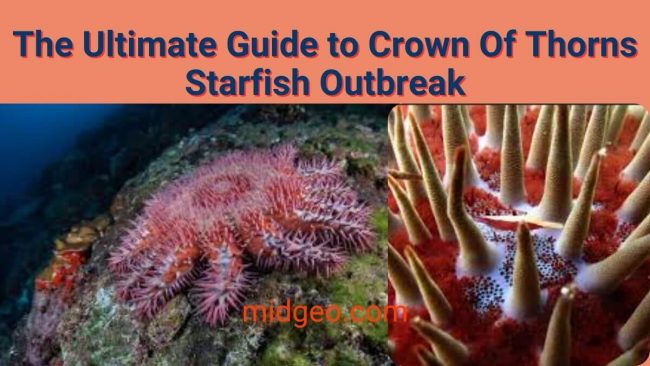The Ultimate Guide to Crown Of Thorns Starfish Outbreak

The crown of thorns starfish outbreak is a major factor in the ongoing loss of coral reefs to coral reefs across the Indian and Pacific Oceans, threatening the productivity of these important marine ecosystems and biodiversity. In this you can find, The ultimate guide to the crown of thorns starfish outbreak, its fascinating facts, and Scientific name and classification. If you are ready, then Let’s go to read about Crown Of Thorns Starfish Great Barrier Reef.
Crown Of Thorns Starfish

The crown of thorns is the starfish (Acanthester planci), which is the second-largest starfish in the world and can be more than half a meter wide. They eat coral almost only as adults – and they eat a lot. They are also highly fertile and can produce up to 50 million eggs during the breeding season, leading to outbreaks when appropriate environmental conditions occur.
Crown Of Thorns Starfish Scientific Name
Acanthaster planci
Scientific classification
Crown Of Thorns Starfish Outbreak – Mid Geo
Kingdom: Animalia
Phylum: Echinodermata
Class: Asteroidea
Order: Valvatida
Family: Acanthasteridae
Genus: Acanthaster
Species: A. planci
10 Cool Facts about the Crown of Thorns Starfish

1. Largest sea star
Scientists are trying to rename the starfish the “sea star” because starfish are not fish; They’re not even close to fish!
If you can think of any other animals that are named incorrectly? The crown of thorns sea star is the second largest sea star in the world; Growing up to a 2.5-foot diameter. The only larger sea star in the world is the sunflower star. It can grow up to a three-foot diameter.
Sea stars move their legs, and hundreds of little feet by changing the water pressure throughout their bodies. Their tube-like feet can actually allow them to move quickly. About 65 feet per hour!
2. No b*lood or brains.
Starfish don’t have b*lood. Instead, they pump seawater through their bodies to bring nutrients to their cells. They will never bleed to death in the water, but this makes them super vulnerable when they are on land. Starfish don’t have lungs. Instead, each of their cells individually relies on simple diffusion for gas exchange. Most starfish can only hold their breath for about 30 seconds out of the water before they die of carbon dioxide poisoning. Starfish also don’t have a brain!
However, they do have a nervous system and will react to pain and environmental stimulus. They even have eye spots at the end of each leg, helping them stay hidden in the darkness.
Having no brain suggests that starfish are not conscious and therefore cannot suffer.
3. Starfish regeneration.
Starfish can lose legs from predatory attacks. Sometimes they even release a leg on purpose to allow a predator to eat it while they escape! Lost limbs take about six months to regrow. Amazingly, if a removed limb is not injured too badly, it can regrow into an entirely new starfish! regeneration makes it hard for divers to kill the crown of thorns starfish.
Sometimes they have to inject every leg individually with poison to make sure the entire thing dies. A more certain killing solution is to just remove them from the water.
4. Outbreaks and farm runoff
Usually, few starfish survive the larval stage. Algae and phytoplankton are the larva’s main food source. In normal, clean, coastal water there are not enough nutrients for dense algae and plankton blooms. There is simply not enough food present for millions of starfish larva to survive. But if there is an extreme weather event like a cyclone, sometimes farm runoff will mix into the breeding ground. Algae and plankton will feed on the dissolved farming fertilizers and bloom. Now we have a big problem!
Way more starfish survive former life, and there is an outbreak. On the Great Barrier Reef, during an outbreak, which lasts over 15 years and several generations, a massive swarm of crowns of thorns starfish sweeps southward. Devouring the corals in its path!
5. External reproduction.
Compounding this problem is the insane number of offspring a female can produce. Every year one female starfish can release over 10 million eggs into the water. These eggs are fertilized externally and then drove around to new reefs in the currents.
Crown of thorns starfish cluster together during the mating season into groups called “aggregations.” Multiple starfish release all of their eggs and sperm at the same time into the water column. This act is called “broadcast spawning.” Releasing hundreds of millions of gametes at the exact same time increases the chances of external fertilization.
- Sea Bunny Slug Facts & Cute Secrets: Discover the Tiny Ocean Creatures That Look Like Fluffy Rabbits
- World Whale Day 2024: Celebrating These Magnificent Creatures
- Celebrating National Polar Bear Day 2024: Raising Awareness for the Arctic Icon
- What is the Cutest Deep Sea Creature?
- Red Parrot Fish Information For First
Also, having millions of larva birthed at the same time reduces the chances that all of them would fail… It’s safety in numbers! Interestingly, when marine biologists put water that smells the giant triton snail near an aggregation, the breeding starfish will disperse! This might ruin the broadcast spawning event and significantly decrease future population numbers!
6. Population control efforts
Marine biologists hope to introduce more snails to reef ecosystems to naturally control the population, but the giant triton snail population is currently very low. They have been over-fished for their impressive two-foot-long shells.
Even if more snails are introduced, they can only eat one starfish per week each. This means that humans are resorting to unnatural means to reduce the crown of thorns starfish population.
Tourism on the great barrier reef alone is a 6.4 billion dollar industry. Dive companies will often let starfish exterminators tag along with them for free. Injecting the starfish with bile salts or vinegar has proven effective. It breaks down their cell membranes from the inside out.
But divers can only inject one at a time, and there are millions of these starfish on the reef. A more effective way to control the population might be to stop the crown of thorns starfish from reproducing.
7. Natural predators.
There are, however, some animals that can penetrate the crown of thorn starfish’s defenses. Pufferfish, harlequin shrimp, and the giant triton snail are immune to the starfish’s toxins. The giant triton snail can impale the starfish with its serrated proboscis and inject paralyzing saliva inside.
The giant triton then can slowly sand the spikes down and pull them apart. The crown of thorns starfish can smell the snail’s presence, and the scent causes them to flee or disperse!
8. Coral Killers
The crown of thorns starfish is a nocturnal predator that feeds on corals. At night the starfish will crawl out of its hiding spot and on top of living corals. Starfish have mouths on the bottom. It then ejects its stomach out of its mouth, inside out, onto the reef. Stomach enzymes digest the coral externally. This animal will then contract its stomach and crawl onto a new fresh patch of coral.
As it moves, it leaves behind a trail of white, calcium carbonate coral skeletons. These starfish can also eat barnacles, sponges, and even algae or plankton if they have to. The Great Barrier Reef has been reduced to half of its size in the last 30 years. The crown of thorns starfish is a main cause of the destruction… second to only climate change!
9. Strong defenses
The crown of thorn starfish is nearly indestructible. It is covered in thick leathery skin and plated with rock-hard calcium carbonate. It also has 7 to 23 arms covered in 2-inch spikes. These spikes are sharp enough to puncture a wetsuit or fish scales! And they’re brittle.
This means they often snap off and lodge themselves in the flesh, causing a long-term injury with acute infection risk. These spikes are also coated in a toxin called “saponin.” Saponin makes the spikes more dangerous but also takes the crown of thorn starfish off of the food menu for most animals.
That they are not conscious and are a major threat to reef ecosystems leads most humans to not think twice about killing them.
10. Ecological benefits
Coral was one of the first animals to develop and it survived alongside the crown of thorns starfish for hundreds of millions of years. The crown of thorns starfish is becoming an invasive species because human activity is artificially changing the water chemistry of reef ecosystems.
The predator-prey balance is shifting in favor of the starfish, against giant triton snails, and against corals. A potential benefit of the crown of thorn starfish is that it eats mostly fast-growing, hard corals.
In small numbers, the crown of thorn starfish will make room for the rarer, slow-growing, soft corals in reef ecosystems. For today, the “culling” of the crown of thorn starfish will continue until the coral they feed on is no longer at risk of extinction.
However, I hope you have gotten The crown of thorns starfish facts if you have that and want to help to control the thorns starfish outbreak. In this, I have tried to give you some information about Facts, Sting, Diet, Eating Coral.





